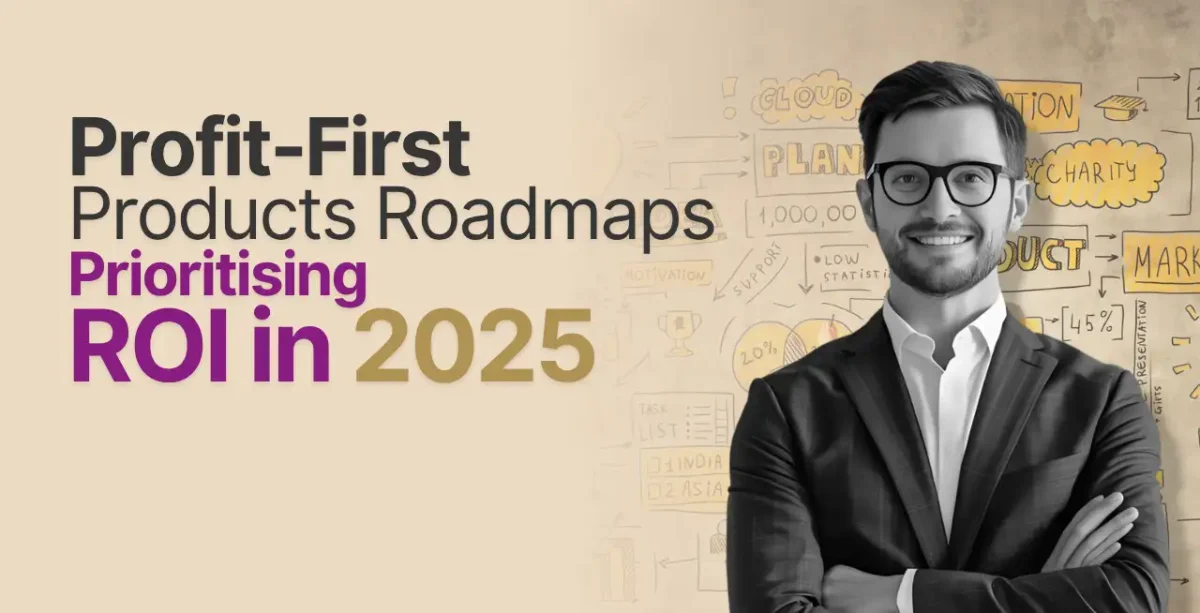Last Updated on October 31, 2025 by Techcanvass Academy
Table of Contents
Overview
With the year 2025 in sight, a successful product roadmap strategy goes beyond features and innovation; it is about measurable business impact. A profit-first approach toward product management enables teams to prioritize efforts on ROI-driven activities that ultimately sustain growth through the turbulence. Connecting every feature, improvement, or experiment to clear financial outcomes, product managers can really drive profitability with strategies.
What Is a Profit-First Product Roadmap?
Profit-first product roadmaps approach road mapping and prioritization of product initiatives with a focus on return on investment (ROI). Whereas users and technology driven features constituted the main focus of product roadmaps, with profit-first roadmaps, product management shifts focus to profit margins.
A Profit-First Product Roadmap prioritizes every feature, enhancement, or experiment based on its projected ROI — ensuring every initiative directly contributes to revenue growth, cost reduction, or customer retention.
With the paradigm of profit-first roadmaps, for each and every feature, improvement, and every experiment, the projected profit it is likely to bring must justify the idea of its inclusion in the product. Consequently, this will shift product management to become exclusively a growth driver. Every initiative will have an ROI threshold of increased revenue, decreased costs, or improved customer retention. The Importance of Profit-First Thinking in 2025.
The reasoning behind managing products with a focus on ROI has become increasingly compelling due to:
The Importance of Profit-First Thinking in 2025
- The market saturation and competition parameters. With respect to SaaS and technology, most verticals have become saturated, and the focus has moved to profit optimization rather than user base growth.
- The expectations of investors and stakeholders. To ensure investors’ continued participation and fund flow, the organization’s management must show projected returns on investments.
- The time and resource constraints. For any product team, time and budget resources must be tightly controlled, thus, resource optimization becomes critical.
- The value to customers. The audience of the product demands measurable value and business results, not just gleaming new features.
A Profit-First roadmap connects product choices with targeted and measurable business outcomes. These roadmaps become crucial for product managers looking to create leading strategies and realize value for the firm.
Prioritizing Profits: The Product Roadmap Perspective
From the perspective of a product manager, this roadmap comprises four principal elements, outlined as follows:
Financial and Strategic Goals
Reach consensus with the company’s upper management regarding the definition of “profit,” as contained within the business definition. For instance, is a “profit” considered a growth of 20% recurring revenue, maintaining a churn rate of 5% and below, or cutting annual operational costs by $500,000? These goals will guide the prioritization process to be done within the roadmap.
Evaluate Each Initiative Using ROI
Each product manager evaluates objectives using the RICE framework – Reach, Impact, Confidence, and Effort, and ROI scoring systems. Each component is evaluated according to:
- Potential savings or generating revenue,
- Confidence level,
- Effort expected, and risk, this evaluation eliminates those which do not bring financial value.
Financial Value Impact Assess, Prioritize, and Plan
Roadmaps must communicate and visually represent a value hierarchy. Prioritize planning for Quick wins – tasks that require minimal effort, are easy to execute, and provide strong returns for the relative effort. Conversely, strategies that require a longer time to payback will require more extensive planning and monitoring. Track, assess and adapt must own the time frame.
A roadmap must be dynamic. It must flow like a living roadmap.
Product Managers assess KPI such as revenue growth and churn, and actuals against forecast. This is a form of feedback for accountability and enhances prioritization.
Focused Road mapping Leads to Profit Improvement: A Case Study.
Take, for instance, a supply chain SaaS company that, despite an increase in customers, showed flat profits. Some activities taken to create profits include:
Focused Road mapping Leads to Profit Improvement: A Case Study
Take, for instance, a supply chain SaaS company that, despite an increase in customers, showed flat profits. Some activities taken to create profits include:
- Building customer onboarding automation to replace expensive manual customer support.
- Adding prioritized security features to accelerate enterprise deals.
- Adding analytics to existing customer accounts to enable upselling.
- Deferring low ROI requests.
Within a six month period, this company realized:
- Increased profits by 40%.
- Reduced customer churn, improved 7% to 4.5%.
- Improved operational use of resources.
The profit focus and improved churn provided a boost in organizational confidence.
How to Help PMs With This Issue
There will always be a gap in the value of completing a product and the actual profits it will generate. This gap must be communicated to stakeholders. Providing a balance of shorter- and longer-term goals will ease the gap in product completion.
Involving other departments in the shift of mindset of “what features do users want?” to “what is the profit/what will this impact on the bottom line?” will be an important first step. This will be an educative task that will involve other departments.
Estimating ROI is often imprecise and may provide the user with data limitations.
Historical data, customer insights, and A/B test results will build confidence.
Conclusion
As organizations refine their product roadmap strategy, today’s product managers are no longer pigeonholed into feature delivery. The focus is now on building alignment between product vision and business outcomes: making sure every roadmapping decision drives profitability, stakeholder confidence, and nonstop growth.
With profit-first roadmaps, product managers evolve from feature delivery to strategic leadership — driving profitability, stakeholder confidence, and sustainable business growth.
They will, therefore, be the gap between strategy and execution in the future, too-up until 2025 and beyond-product managers who will be the architects of sustainable growth, innovation, and organizational excellence.
FAQs
Q1. What is a Profit-First Product Roadmap?
The Profit-First Product Roadmap lays its focus on prioritization of features, improvements, and experiments based on the projected ROI. Contrasting with traditional roadmaps that emphasize either user or technology-driven goals, this approach makes sure each and every initiative contributes directly to increased revenue, reduced costs, or even customer retention.
Q2. Why is a Profit-First Product Roadmap important for companies in 2025?
In 2025, it is about profit-first thinking in product decisions that align with business growth. As markets get saturated and investor expectations increase, a Profit-First Product Roadmap is the key to helping teams manage time and resources while delivering measurable business outcomes.
Q3. How does a product roadmap strategy help in improving ROI?
A well-structured product roadmap strategy lets product managers evaluate each initiative on different frameworks, such as RICE (Reach, Impact, Confidence, and Effort). Having connected every roadmap item with its financial impact, PMs can focus on initiatives driving higher returns and eliminate low-ROI projects.
Q4. What are the key elements of building a Profit-First Product Roadmap?
The core ingredients of this: setting clear financial and strategic goals, making sure ROI scoring of each initiative is done, and continuous tracking of financial outcomes. The roadmap needs to be dynamic; it constantly adapts to market changes but keeps profitability and customer value at its heart.
Q5. How does a profit-first approach transform a product manager’s role?
The Profit-First Product Roadmap takes product managers from a focus on merely delivering features, into the realm of strategic leadership. They are tasked with ensuring alignment in product decisions to business objectives, holding accountabilities toward profit-driven outcomes, and lead sustainable organizational growth.
Q6. Can you share an example of how the Profit-First Product Roadmap impacts results?
Yes, a SaaS company that supplied the chain implemented a Profit-First Product Roadmap; thus, onboarding automation, advanced security, and analytics for upsell started to happen. In six months, the company increased its profits by 40%, reduced churn from 7% down to 4.5%, and optimized resources of operations.
Q7. How can I learn to create a product roadmap strategy or Profit-First Product Roadmap?
Techcanvass has introduced the most comprehensive Product Management Course if one is aiming to master modern product roadmap strategy and hands-on product management.



